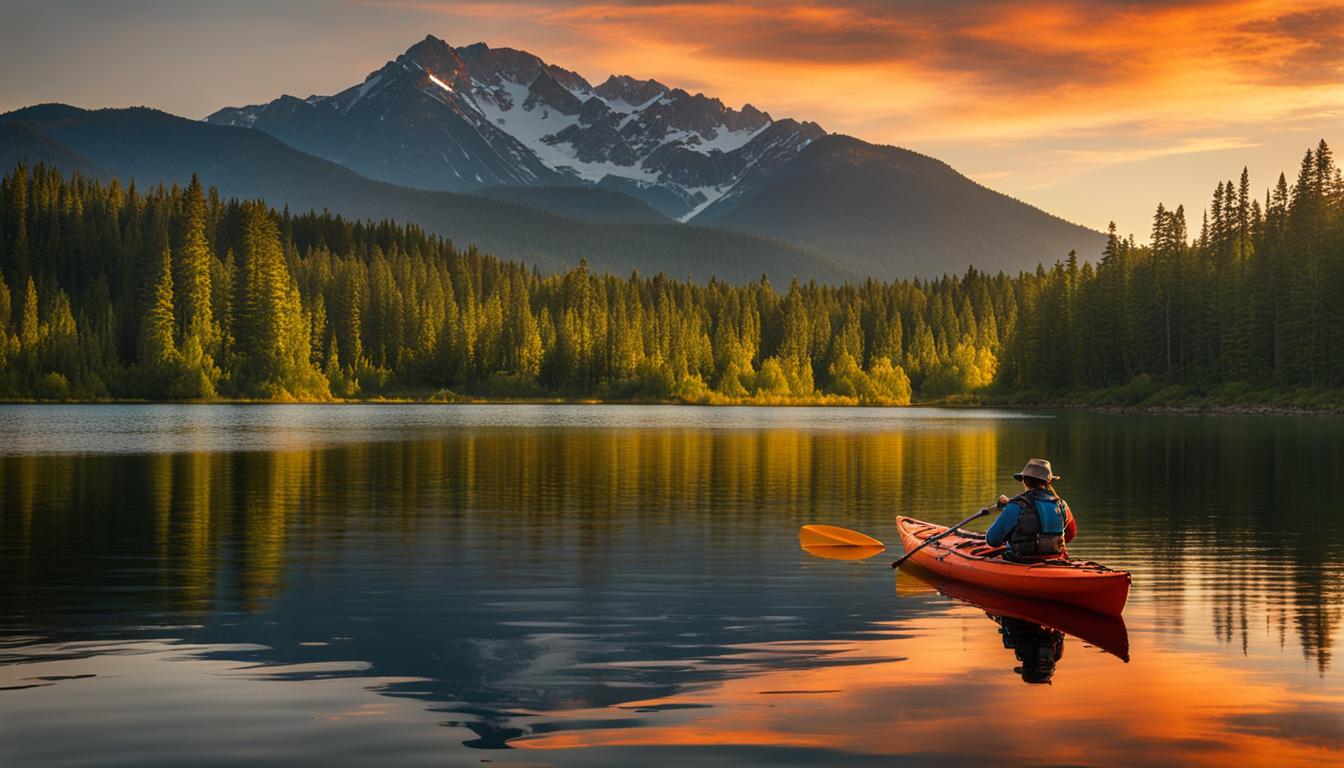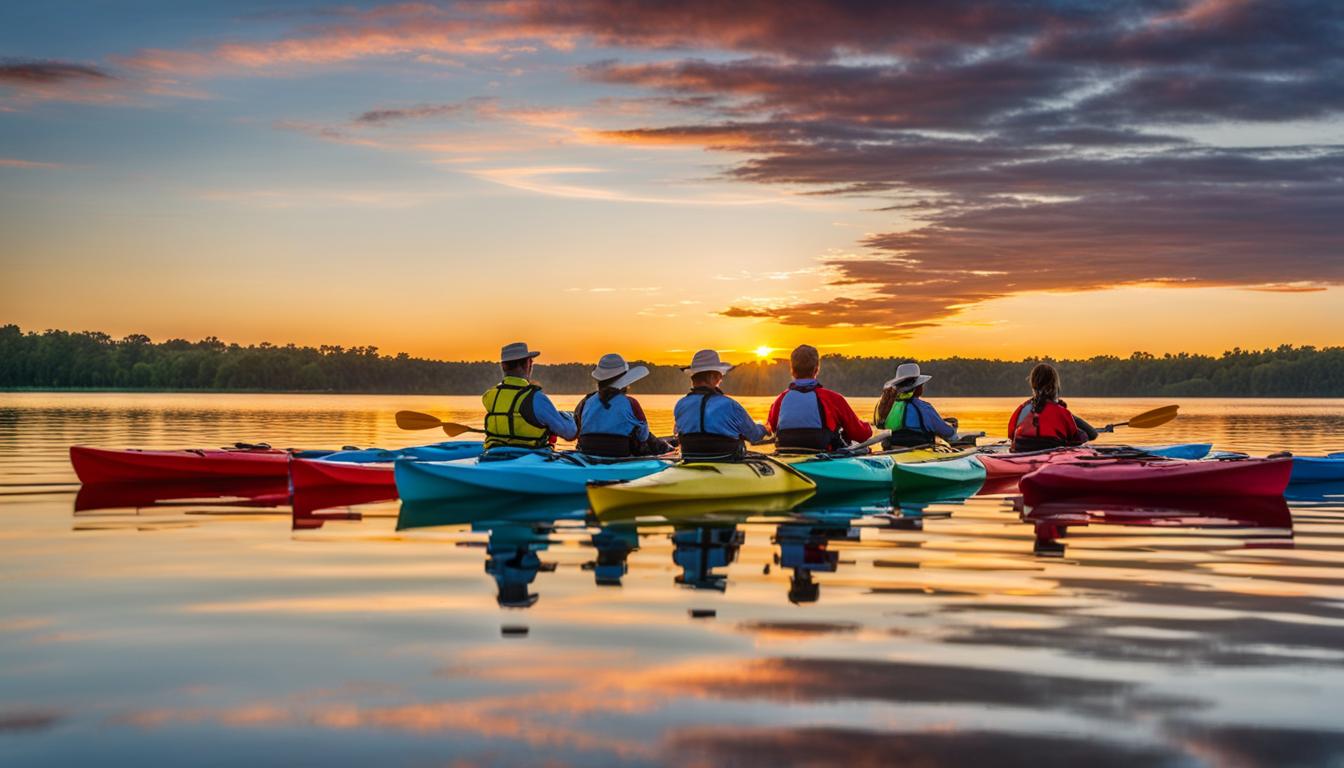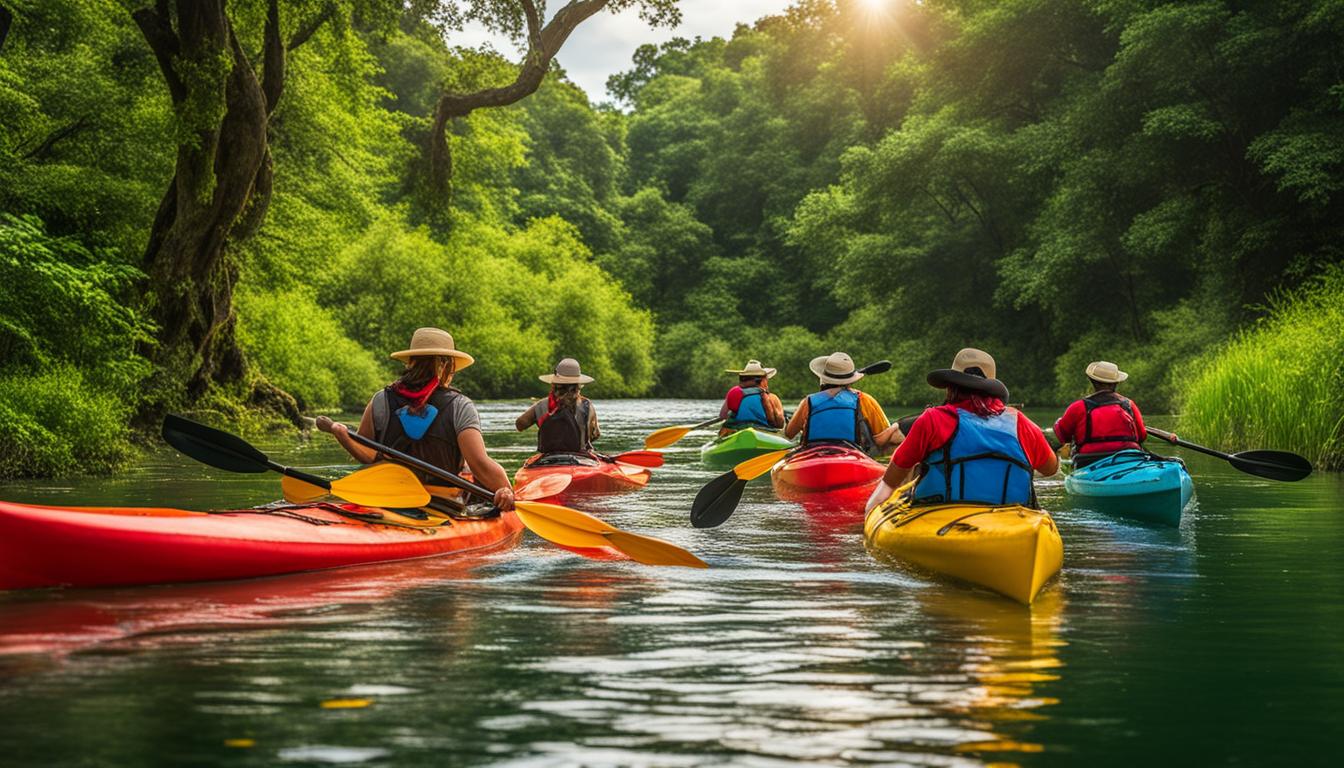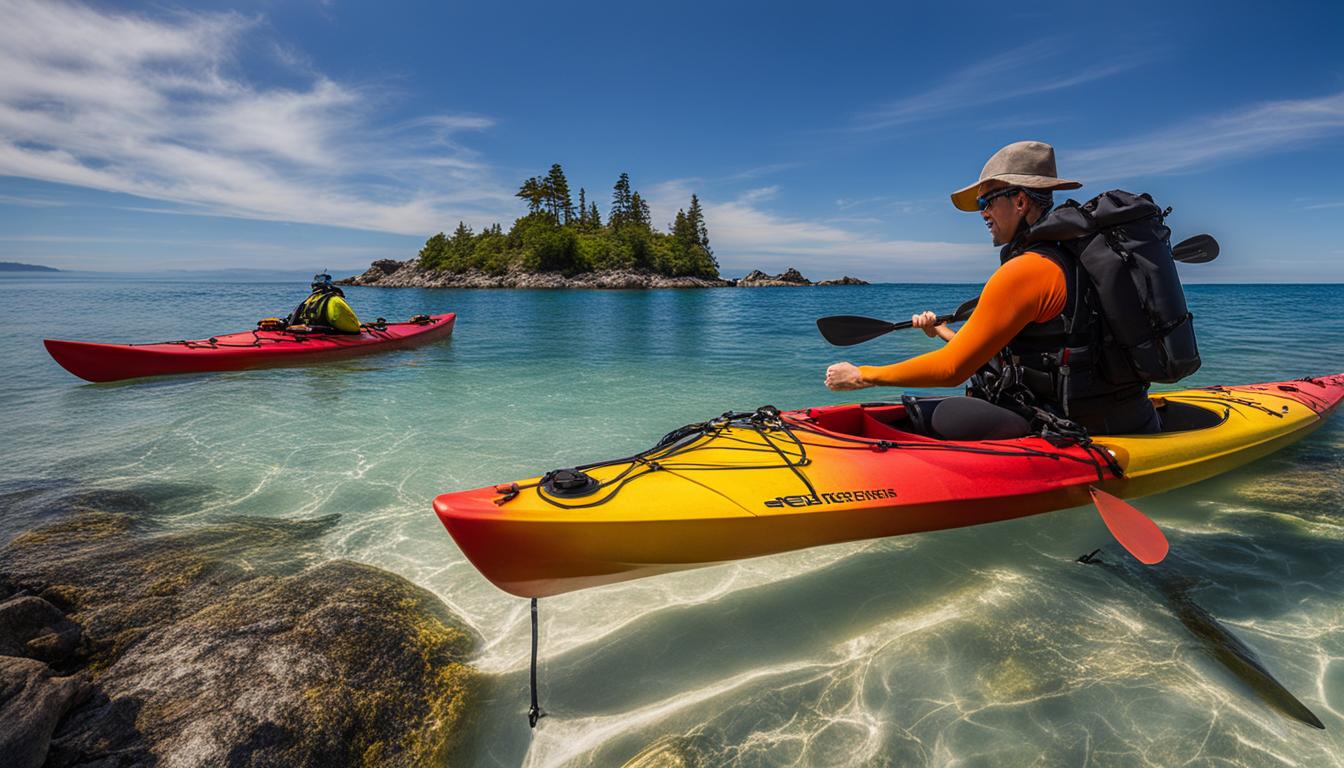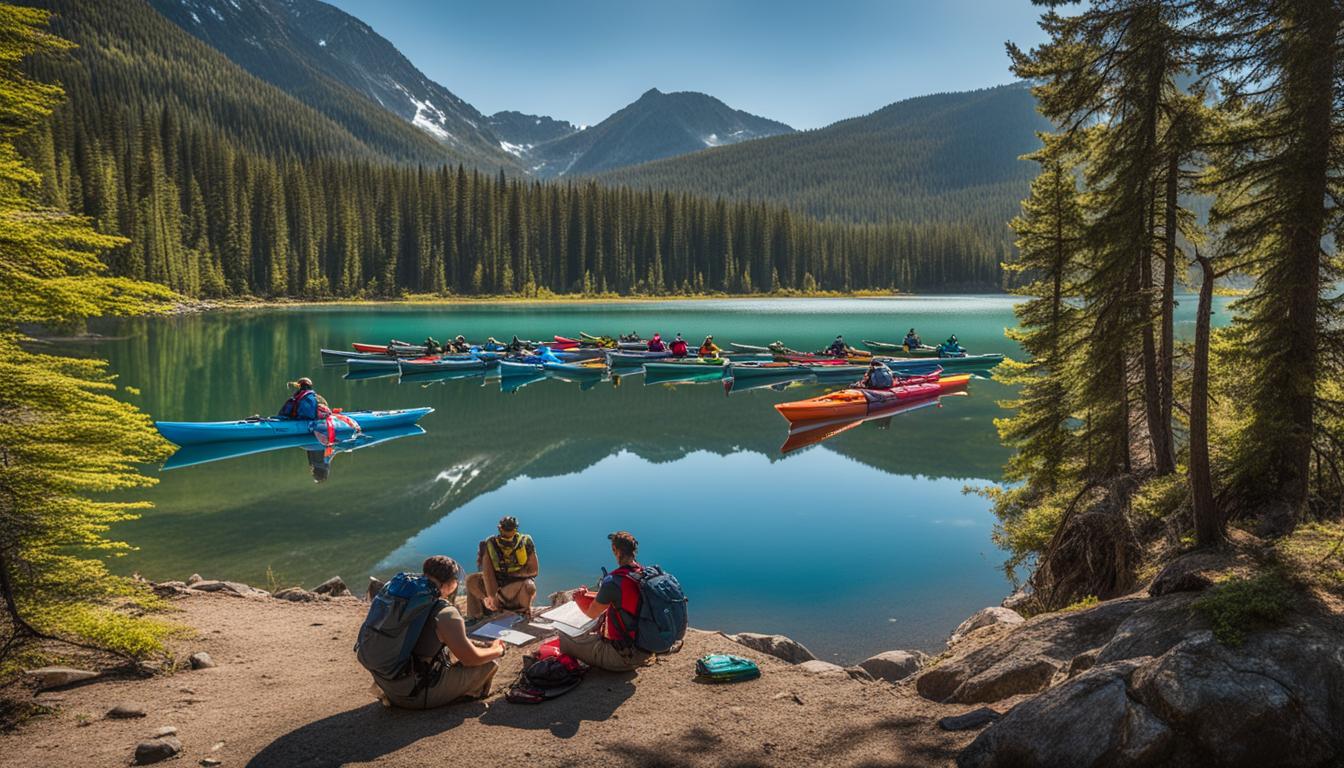Kayak fishing is a fantastic way to spend time outdoors, combining the joys of camping and fishing into one exciting adventure. Whether you’re a seasoned angler or a beginner, with the right gear and tips, you can have a successful and enjoyable experience.
When it comes to choosing a kayak for fishing while camping, there are a few factors to consider. You’ll want to think about the type of water you’ll be fishing in, your height and weight, and your paddling ability. It’s also essential to invest in a good personal flotation device (PFD) and wear it at all times for safety.
Starting with affordable fishing gear options is a good idea, especially if it’s your first few trips. Being self-reliant and prepared is crucial when kayak fishing, so always carry essential items in your fishing PFD. Additionally, doing your homework and finding your own fishing spots will enhance your experience.
Don’t forget to stay hydrated and protect yourself from the sun on those long days out on the water. With these tips in mind, you’re ready to embark on an incredible kayak fishing camping adventure.
Key Takeaways:
- Choose a kayak based on your size, paddling ability, and the type of water you’ll be fishing in.
- Invest in a good PFD and wear it at all times for safety.
- Start with affordable fishing gear options to avoid bringing expensive rods on your first few trips.
- Be self-reliant and prepared by carrying essential items in your fishing PFD.
- Research and find your own fishing spots for a more rewarding experience.
Choosing the Right Fishing Kayak
When embarking on a kayak fishing camping adventure, selecting the right fishing kayak is crucial to ensure a successful and enjoyable experience. The choice of kayak will depend on various factors, such as the type of water you’ll be fishing in, your body build, and your paddling ability.
Consulting with experienced kayakers can provide valuable insights and guidance on the best kayak for your specific needs. They can help you consider important factors like water conditions, stability, and maneuverability. Additionally, they can provide recommendations based on your camping gear requirements and the type of fishing you plan to do – whether it’s in freshwater or saltwater.
Remember: a well-suited kayak will enhance your fishing experience by providing comfort, stability, and ease of maneuverability, allowing you to navigate through any fishing conditions.
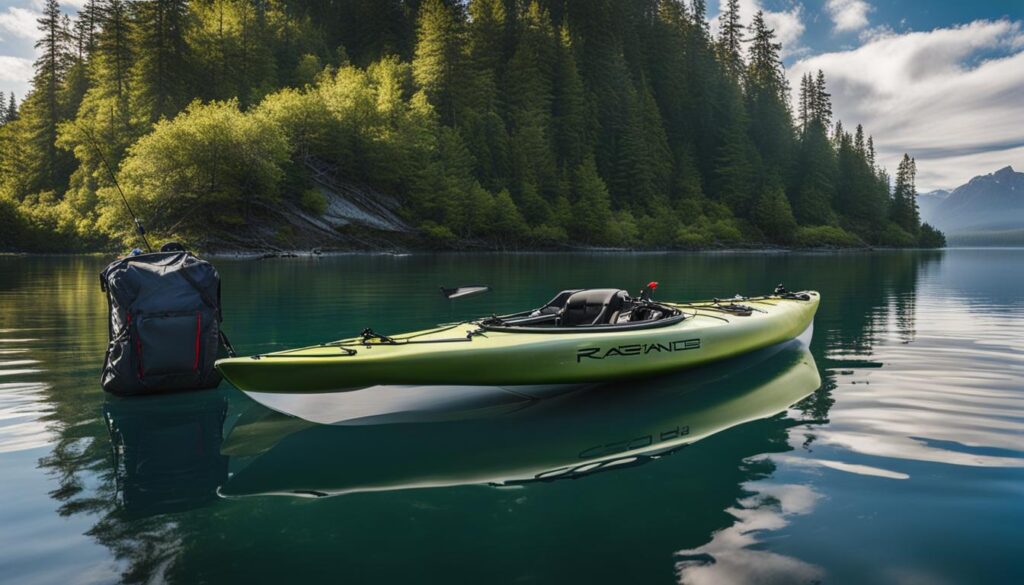
Essential Gear for Kayak Fishing Camping
When heading out for a kayak fishing camping trip, packing the right gear is essential for a successful and enjoyable experience. You’ll need to consider your fishing style and the specific type of fish you’ll be targeting in order to bring the necessary bait and tackle. Researching the best fishing spots in the area you’ll be camping can also help you plan your trip effectively. To keep your gear organized and dry, invest in dry bags that will protect your equipment from water damage. Additionally, don’t forget to pack essential tools such as a knife, duct tape, compass, signaling devices, a multi-tool, matches or a firestarter, a waterproof cellphone case, rope or paracord, a water filter, and a first-aid kit.
“The gear you bring on your kayak fishing camping trip can greatly impact your overall experience. By packing the right bait and tackle and researching the best fishing spots, you’re setting yourself up for success. Don’t forget to pack essential tools and equipment to ensure your safety and preparedness in any situation.”
Table 1 below provides a comprehensive list of essential gear for kayak fishing camping:
| Item | Description |
|---|---|
| Bait and Tackle | Bring the necessary bait and tackle based on your target fish species. |
| Dry Bags | Invest in dry bags to keep your gear dry and organized. |
| Knife | A reliable knife is a must-have tool for various tasks in outdoor settings. |
| Duct Tape | Duct tape can be incredibly useful for quick repairs and improvised solutions. |
| Compass | A compass will help you navigate and stay on course during your trip. |
| Signaling Devices | Carry signaling devices such as a whistle or flare for emergencies. |
| Multi-Tool | A versatile multi-tool will come in handy for various tasks. |
| Matches/Firestarter | Pack matches or a firestarter to start a fire for cooking or warmth. |
| Waterproof Cellphone Case | Protect your cellphone from water damage with a waterproof case. |
| Rope or Paracord | Rope or paracord can be used for various purposes, including setting up a shelter. |
| Water Filter | A water filter will provide you with safe drinking water during your trip. |
| First-Aid Kit | Always carry a well-stocked first-aid kit for minor injuries and emergencies. |
By ensuring you have the right gear for your kayak fishing camping trip, you’ll be well-prepared and ready to make the most of your outdoor adventure. Whether you’re targeting specific fish species or exploring new fishing spots, having the necessary equipment and tools will contribute to a successful and enjoyable experience.
Tips for Packing and Weight Distribution
When you’re preparing for a kayak fishing camping trip, it’s crucial to pack efficiently and distribute the weight properly. By following these tips, you’ll ensure a smooth and enjoyable experience on the water.
Packing Minimally and Efficiently
Start by laying out all your gear and categorize it into like piles. Then, eliminate items that are not necessary for your trip. Remember, less is more when it comes to kayak fishing camping. Pack everything into dry bags or zip-lock bags to keep things organized and dry. This will also make it easier to access your gear when needed.
Consider Weight Distribution
When loading your gear into the kayak, it’s important to consider weight distribution. Place heavy items towards the center of the kayak to maintain balance and stability. This will help you paddle more efficiently and prevent your kayak from tipping over in choppy water conditions. Before your trip, it’s a good idea to pre-pack your kayak to determine what gear fits and where it should be placed. This will save you time and frustration once you’re out on the water.
Leave a Float Plan
Always leave a float plan with someone who can reach out for help if needed. Include a detailed description of your kayak, emergency contacts, and a thorough itinerary. This information will be vital in case of an emergency situation, ensuring that help can be dispatched to your location quickly and efficiently.
Kayak Fishing Safety Tips
While packing and weight distribution are important, safety should always be your top priority. Wear your personal flotation device (PFD) at all times, even if you’re a confident swimmer. Familiarize yourself with kayak fishing safety techniques, such as how to self-rescue and how to handle different water conditions. It’s also crucial to check local laws and regulations before your trip to ensure you are in compliance. By practicing proper safety precautions, you’ll have peace of mind and can fully enjoy your kayak fishing camping adventure.
| Essential Packing Tips | Weight Distribution | Safety Precautions |
|---|---|---|
|
|
|
By following these tips for packing and weight distribution, as well as prioritizing safety, you’ll be well-prepared for a successful and enjoyable kayak fishing camping trip.
Safety Precautions and Legal Considerations
When it comes to saltwater kayak fishing strategies and kayak fishing safety, there are several important precautions and considerations to keep in mind. By prioritizing your safety and adhering to local laws and regulations, you can ensure a safe and enjoyable experience on the water.
Safety Precautions
First and foremost, always wear your personal flotation device (PFD) while kayak fishing. Even if you consider yourself a strong swimmer, unexpected situations can arise, and a PFD can be a lifesaver. Additionally, familiarize yourself with kayak fishing safety techniques, such as how to properly launch and land your kayak, how to handle challenging weather conditions, and how to rescue yourself or others in case of an emergency. Taking a kayak fishing safety course can provide valuable knowledge and skills for handling various situations that may arise while on the water.
It’s also essential to be prepared for any scenario. Before heading out, check the weather forecast and be aware of any potential hazards or changes in conditions. Carry essential safety equipment, including a whistle for signaling, a throw rope for rescues, a first-aid kit, and a fire extinguisher. Familiarize yourself with the area you’ll be fishing in, noting potential hazards such as strong currents, submerged obstacles, or areas with restricted access.
Legal Considerations
When engaging in kayak fishing, it’s crucial to respect and adhere to local laws and regulations. Before your trip, research any permits or licenses that may be required for fishing in the area. Some regions may have specific rules and restrictions regarding catch limits, protected species, and fishing methods. Be mindful of any fishing seasons or closures that are in effect to ensure you’re fishing within the legal guidelines.
Additionally, practice “leave no trace” principles to minimize your impact on the environment. Properly dispose of any trash or waste and avoid damaging sensitive habitats. Be aware of any fire restrictions in the area and make sure to completely extinguish any fires. By following these legal considerations, you can contribute to the preservation and sustainability of the marine environment.
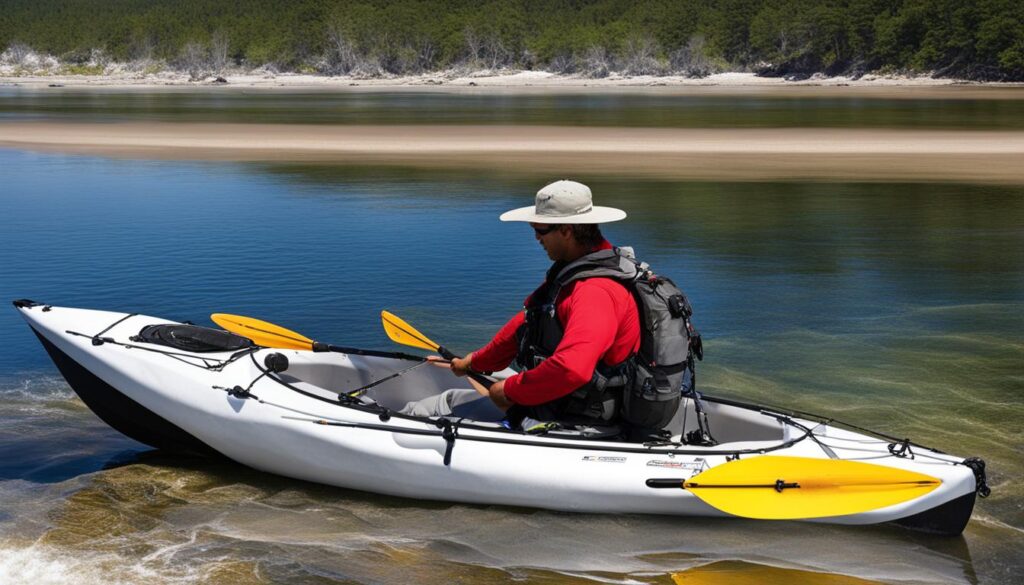
| Important Safety Precautions | Legal Considerations |
|---|---|
|
|
Tips for Enjoying the Experience
While kayak fishing camping, it’s important to fully embrace the experience and enjoy it to the fullest. Hone your kayak angling techniques and spend time exploring and learning the patterns of the fish in the area. Take the time to plan your fishing trips in advance, researching fishing reports, using tools like Google Earth, and seeking advice from experienced kayak anglers. Embrace the adventure and have a sense of curiosity and discovery. Remember that even a bad day of fishing is still a good day spent kayaking. Enjoy the exercise, the beauty of nature, and the thrill of the catch.
Exploring Kayak Angling Techniques
One of the joys of kayak fishing is the opportunity to refine your angling techniques. With a lower vantage point and a more intimate connection to the water, you can develop a deeper understanding of fish behavior. Experiment with different lures and baits, varying your retrieval techniques, and observing how fish respond. Pay attention to weather patterns, water conditions, and the presence of underwater structures or vegetation that may attract fish. By constantly learning and adapting, you’ll become a more skilled kayak angler and increase your chances of success.
Proper Planning for Kayak Fishing Trips
Before embarking on a kayak fishing trip, take the time to plan and prepare. Research the body of water you’ll be fishing in, looking for information on fish species, their habits, and preferred baits. Check local regulations to ensure you have the necessary permits and follow any rules or restrictions. Plan your route and identify potential launch and landing points. Consider the weather forecast and be prepared for changing conditions. Make a checklist to ensure you have all the essential gear and supplies, including safety equipment, food, and water. Proper planning will help make your kayak fishing trip more enjoyable and increase your chances of a successful outing.
Embracing the Adventure
Kayak fishing camping is not just about catching fish; it’s about embracing the adventure and immersing yourself in the beauty of nature. Take the time to appreciate the peacefulness of gliding across the water, the sights and sounds of wildlife, and the tranquility of a serene fishing spot. Allow yourself to be fully present in the moment, savoring each cast and relishing the thrill of the catch. Disconnect from the demands of everyday life and let the rhythm of the water soothe your soul. Whether you’re fishing alone or with friends, make the most of your kayak fishing camping experience and create memories that will last a lifetime.
| Top Tips for Enjoying the Experience |
|---|
| 1. Hone your kayak angling techniques through experimentation and observation. |
| 2. Plan your fishing trips in advance, researching fishing reports and seeking advice. |
| 3. Embrace the adventure and enjoy the exercise, nature, and thrill of the catch. |
| 4. Explore different kayak angling techniques to become a more skilled angler. |
| 5. Properly plan your kayak fishing trips, considering weather, regulations, and supplies. |
| 6. Embrace the adventure and immerse yourself in the beauty of nature. |
Conclusion
Planning a kayak fishing trip is an exciting endeavor that allows you to combine your love for fishing with the thrill of camping. By following the tips provided in this guide, you can ensure a memorable and successful adventure on the water. From choosing the right fishing kayak to packing essential gear and practicing safety precautions, each step plays a vital role in maximizing your enjoyment.
Proper trip planning is key to a successful kayak fishing experience. Take the time to research fishing reports, utilize tools like Google Earth, and seek advice from experienced kayak anglers. This preparation will help you make informed decisions and increase your chances of a fruitful fishing trip.
Additionally, don’t forget to hone your kayak angling techniques. Spend time exploring the fishing patterns in your chosen area and embrace the adventure of discovering new techniques. Remember, even if the fish aren’t biting, the beauty of nature and the joy of kayaking are experiences worth cherishing. So, pack your gear, plan your trip, and get ready to create lasting memories in the great outdoors.
FAQ
What should I consider when choosing a fishing kayak for kayak camping?
When choosing a fishing kayak for kayak camping, consider factors such as the type of water you’ll be fishing in, your height and weight, and your paddling ability. It’s also important to choose a kayak that can accommodate your camping gear and fishing equipment.
What gear do I need for kayak fishing camping?
Essential gear for kayak fishing camping includes bait and tackle suitable for the type of fish you’ll be targeting, a knife, duct tape, compass, signaling devices, a multi-tool, matches/firestarter, a waterproof cellphone case, rope or paracord, a water filter, and a first-aid kit. Dry bags or zip-lock bags are also useful for keeping gear organized and dry.
How should I pack my kayak for a kayak fishing camping trip?
When packing your kayak for a kayak fishing camping trip, prioritize essential items and avoid overpacking. Pack everything into dry bags or zip-lock bags to keep things organized and dry. Consider weight distribution and pack heavy items towards the center of the kayak to maintain balance. Pre-packing your kayak ahead of time can help determine what gear you can fit and where it should be placed.
What safety precautions should I take during kayak fishing camping?
Safety is a top priority during kayak fishing camping. Always wear your PFD and familiarize yourself with kayak fishing safety techniques. Obey local laws and regulations, research any permits or restrictions, and practice “leave no trace” principles. Properly dispose of any trash, put out fires completely, and be mindful of any fire restrictions in the area.
How can I make the most of my kayak fishing camping experience?
Hone your kayak angling techniques, spend time exploring and learning the patterns of fish in the area, and plan your fishing trips in advance. Research fishing reports, use tools like Google Earth, and seek advice from experienced kayak anglers. Embrace the adventure, have a sense of curiosity and discovery, and enjoy the exercise, beauty of nature, and thrill of the catch.

